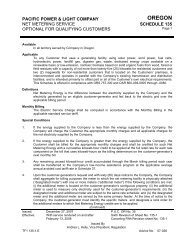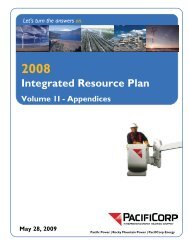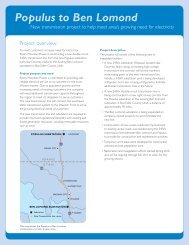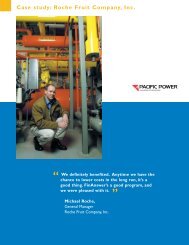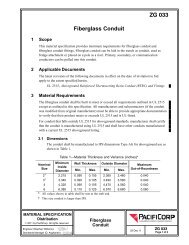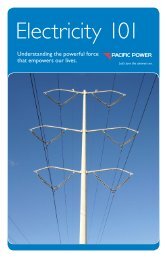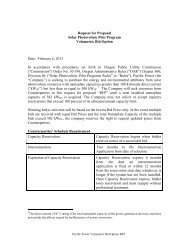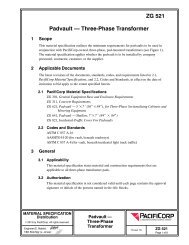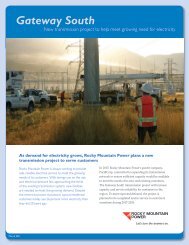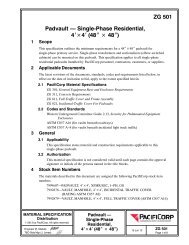2011 Electric Service Requirements Manual, 2nd - Pacific Power
2011 Electric Service Requirements Manual, 2nd - Pacific Power
2011 Electric Service Requirements Manual, 2nd - Pacific Power
Create successful ePaper yourself
Turn your PDF publications into a flip-book with our unique Google optimized e-Paper software.
<strong>2011</strong> <strong>Electric</strong> <strong>Service</strong> <strong>Requirements</strong>, 2 nd Edition<br />
Definitions<br />
ANSI — American National Standards Institute.<br />
Arc flash hazard — A dangerous condition associated with the release of energy caused by an electric arc.<br />
Bushings — Plastic or nylon rings that attach to the ends of conduit to protect the electrical cable from sharp<br />
edges.<br />
Bypass — A method which allows for service continuity to the customer while the meter is removed for test<br />
or inspection.<br />
Common meter — A non-residential meter for general energy use in apartment complexes, multi-use, or<br />
other multi-occupancy buildings. General energy use includes common area and exterior lighting, irrigation,<br />
laundry rooms, etc. Also called a house meter.<br />
CT — Current transformer (see Current transformer).<br />
Current transformer — A set of coils that reduce the primary current to the customer by a known ratio to<br />
an amount within the current capacity of the meter.<br />
Current transformer meter — A meter that requires current transformers because its current capacity is<br />
not as large as the customer’s current load.<br />
Customer — The individual requesting electrical service from <strong>Pacific</strong> <strong>Power</strong> or Rocky Mountain <strong>Power</strong>.<br />
Direct−connect meter — A meter energized to line voltage that carries all the load current. Also called a<br />
self-contained meter. No current transformer or voltage interface is used.<br />
Direct−connect socket — A meter socket connected to service wires, energized to line voltage and in series<br />
with the customer’s load without external instrument transformers. A self-contained meter is used in a direct-connect<br />
socket.<br />
Drip loop — The loop formed by the customer conductors that connects to the power company service<br />
drop. The conductors are formed in a downward “loop” so water will not enter the customer’s service<br />
mast (weatherhead).<br />
Dwelling unit — A single unit, providing complete and independent living facilities for one or more persons,<br />
including permanent provisions for living, sleeping, cooking, and sanitation.<br />
Dwelling, single-family — A building that consists solely of one dwelling unit.<br />
Dwelling, two−family — A building that consists solely of two dwelling units.<br />
Dwelling, multi-family — A building that contains three or more dwelling units.<br />
<strong>Electric</strong> vehicles — See EV below.<br />
ESRA — <strong>Electric</strong> <strong>Service</strong> <strong>Requirements</strong> Agreement, a formal, written agreement between the Company<br />
and the customer that describes the details of each installation. A <strong>Power</strong> Company representative fills out<br />
the ESRA during the design process.<br />
EUSERC (<strong>Electric</strong> Utility <strong>Service</strong> Equipment <strong>Requirements</strong> Committee) — An association of electric utilities<br />
and manufacturers that creates standard designs for the interface between the electric utility’s service<br />
and the customer’s facility.<br />
EV — <strong>Electric</strong> vehicle. An automotive type vehicle for highway use such as passenger cars, buses, trucks,<br />
vans and neighborhood vehicles primarily propelled by an electric motor powered by electrical energy from<br />
rechargeable batteries or other source onboard the vehicle.<br />
v



